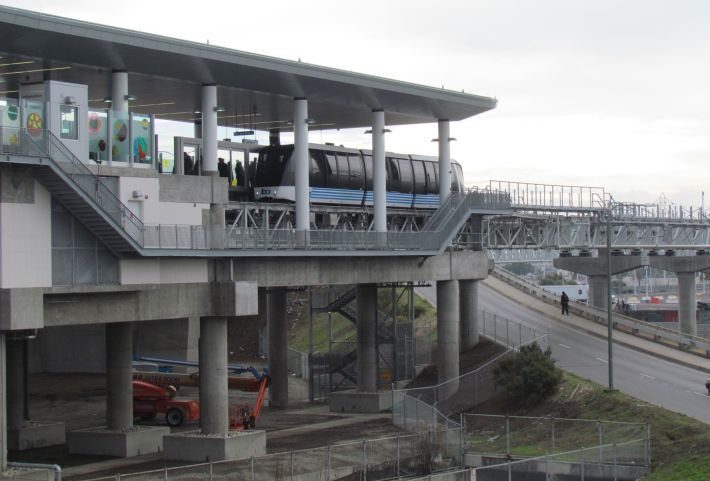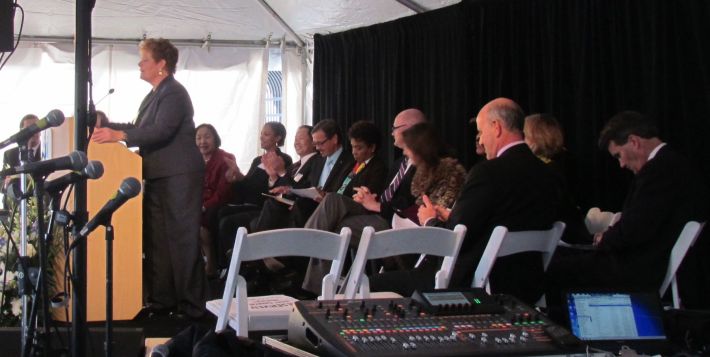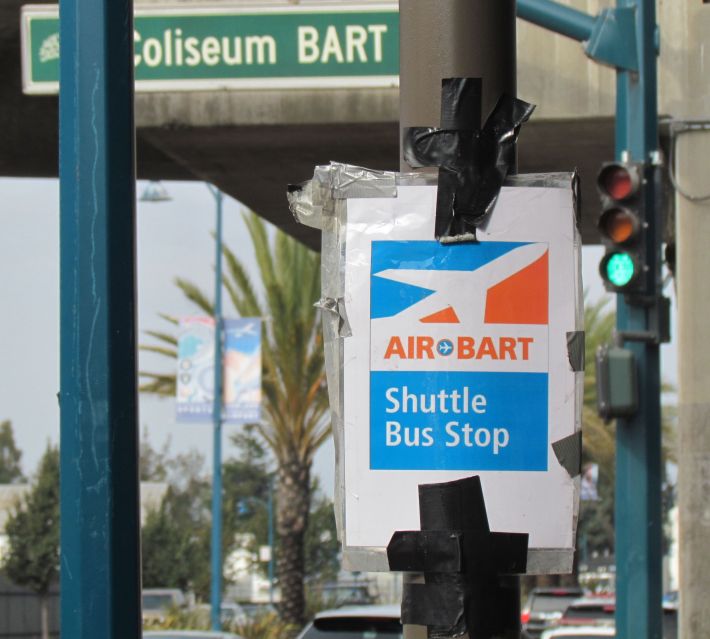Officials Celebrate BART’s Shiny, Costly New Oakland Airport Connector
4:48 PM PST on November 24, 2014

The ribbon was cut Friday on BART's new $484 million Oakland Airport Connector, with a ceremony complete with the requisite speeches, live music, and even a raffle. Free rides were given to everyone who came.
The new cable-propelled system is elegant, clean, quiet, and relatively quick. But it's also a shining example of how BART can misplace its funding priorities by building a new flyover train to serve relatively few passengers while neglecting -- and increasing -- the maintenance costs of the starved larger rail network, as transit advocates argued throughout the years it took to plan and build the OAC. Its $6 fare will leave everyday BART riders paying for the lion's share of its operating costs of $18 to $21 per trip.
“Despite the obvious needs, BART has gone forward with seemingly thoughtless projects like the airport connector,” Joél Ramos, TransForm's regional planning director. “I use the word 'thoughtless' because they didn't give alternatives fair consideration. BART never seriously considered a system integrating dedicated bus lanes, something we know to be efficient and reliable.”
The $6 train trip from the Coliseum BART station to the airport costs twice the fare of the now-defunct AirBART bus, and almost three times the fare of AC Transit's 73 bus route (an underpublicized airport connection). And it doesn't include the fare to anywhere else on BART.
The OAC travels at a sedate 30 mph, taking about eight minutes to get from the Coliseum BART station to the Oakland airport, including a pause in the middle to switch cables. That stop seems long enough to take on passengers, but there's no station there -- just the green corrugated-iron wall of the cable wheelhouse. The lack of a station is just one of the train's many missed opportunities.
Meanwhile, BART's everyday riding experience is in decline, belying its image as a state-of-the-art rail system: Trains are overcrowded at peak hours, doors sometimes won't open, lights won't work, and other equipment failures lead to increasing tube-clogging delays.
At Friday's celebratory ceremony, however, little mention was made of the downsides of diverting resources to the OAC at the expense of the larger system. Officials made speeches focusing on benefits like fewer car trips to the airport, an easier way for travelers to get to San Francisco, and increased transit service for the development planned around Coliseum BART Station.

State Assemblymember Nancy Skinner at least mentioned the “legitimate concerns” that had been raised about the project's costs, but focused on touting its environmental dividends. “So many more people won't use their cars to reach the airport,” she said, pointing out that the electricity that powers BART is mostly from clean energy. “Transit has a cost, but it's one we will all celebrate for years to come.”
Yet the OAC's projected ridership is only expected to equal less than one percent of BART's ridership. And if the BART trip to the connector is crowded and unreliable, will people still forego driving to use it?
BART has long needed a convenient connection with the Oakland airport. The AirBART bus had always been treated as an afterthought: It wasn't integrated into the Clipper card payment system, it was subject to traffic delays, and slow because of the circuitous route chosen to align the buses with the BART exit.
When President Barack Obama's federal stimulus funds targeted “shovel ready” projects in 2009, the idea of building an elevated rail from BART to the airport picked up steam. The project didn't get those $70 million in federal ARRA grants because it failed to properly analyze its effect on the area's low-income population, but the stimulus worked. Local officials and agencies, fired up, worked over the next few years to cobble together the $484 million to fund construction costs from several other federal sources.
Decision makers, focused on creating a seamless connection to BART, overlooked far less expensive alternatives like bus rapid transit improvements for the AirBART route, which would have better served local riders as well.
TransForm was one of the few groups that spoke out against the project, calling it a waste of precious money needed to address BART's more pressing backlog of system maintenance and service upgrades.
“We could have had a dedicated [Bus Rapid Transit] with in-station transfers, with several stations serving new developments between the Coliseum station and the airport, and that could have been expanded north to create a real local transit system. And it would have cost much less money. Instead we got a very expensive, non-local-serving system at the expense of maintenance on the BART system we use daily.”
The recently passed Alameda County sales tax Measure BB will bring an infusion of cash for BART within the county. Its spending plan [PDF] allots $749 million for BART expansion and maintenance, including $400 million for the long-discussed expansion to Livermore.
“The danger is that BART might see this money as a chance to build the next fancy thing. But this should be a time for reflection on the part of BART,” said Ramos. “The good people of Livermore absolutely need better connections to BART, and they need a better alternative to the freeway. But it's disconcerting that the way projects like the Livermore connection are talked about, they are just assumed to be rail projects. It's a narrow focus that doesn't consider the needs of the current system.”
Maintaining a "state of good repair" is "not as glamorous as the brand new, gleaming technology of the Oakland Airport Connector,” said Ramos. “But the rest of the system is showing its age."
Stay in touch
Sign up for our free newsletter
More from Streetsblog Los Angeles
Automated Enforcement Coming Soon to a Bus Lane Near You
Metro is already installing on-bus cameras. Soon comes testing, outreach, then warning tickets. Wilshire/5th/6th and La Brea will be the first bus routes in the bus lane enforcement program.
Metro Looks to Approve Torrance C Line Extension Alignment
Selecting the relatively low-cost hybrid alternative should help the oft-delayed South Bay C Line extension move a step closer to reality





